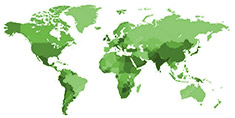Sowing and growing Daisy
A daisy (Leucanthemum) is a perennial plant with white petals and a yellow heart. The daisy originates from Europe and is not only a common garden plant but also a popular flower for bouquets. The plant belongs to the composite family (Asteraceae) and symbolizes innocence, purity, love and simplicity. In addition to thedaisy, there are also other daisy species, such as the Mexican Daisy.
Growing Daisy
Daisy (Leucanthemum) belongs to the composite family. It is a perennial plant, but there are also annual varieties, and has distinctive white petals with a yellow centre. It is an ancient plant that originates from Europe. The plant is edible and is said to have medicinal properties.
Sowing daisy seeds
Sowing is best done in spring (May-June) or in early summer, after the last frost. Before sowing can take place, it is important to prepare the soil well. Remove any weeds, loosen the soil a bit and mix in some compost if necessary. Scatter the daisy seeds over the prepared soil. The seeds can be small, so you can mix them with sand to distribute them better. Since the seeds are light germinators, only lightly press or cover with a thin layer of soil. Water after sowing and keep the soil slightly moist until the seeds germinate. Once the young plants are tall enough to handle, you can thin them out or transplant them.
Location and soil for daisy flowers
Daisy prefers a sunny location and well-drained, moderately fertilized soil.
How to care for your daisy plants
Daisy needs little care. Water regularly, especially during dry periods or when the plants are in pots. Make sure that the roots do not remain in the water, this can lead to rot. Daisies don't need a lot of nutrition but can benefit from some compost or fertilizer in the spring. Cut off faded flowers to encourage a second flowering. When flowering is over, you can prune the plant back to just above the ground. In addition to sowing, daisies can also be multiplied by dividing the plant in the spring.
Is daisy bee and/or butterfly friendly?
Daisies are, due to their open structure and relatively high amount of nectar and pollen, very popular with bees, bumblebees and butterflies.
Daisy in the vegetable garden
Daisies can be a wonderful addition to the vegetable garden. In addition to attracting many pollinators, which are of course also important for pollinating the other crops, it looks beautiful. Moreover, the plant is edible and medicinal properties are attributed to it.
Is daisy edible and/or medicinal?
The daisy is edible and is considered medicinal. The young leaves can be eaten raw in salads or prepared as a vegetable. The taste is bitter and peppery. The petals can be used to make tea or as a garnish. The roots are also edible. The plant is said to have an anti-inflammatory effect and can make a positive contribution to digestion and breathing.
Please note that we at Dutch Garden Seeds do not provide medical advice. Always ask a professional if and how the plant can be used medicinally.
Daisy seeds in our assortment
We have different types of daisy seeds in our range, including organic seeds from the brand 'Buzzy Organic Seeds'.
Tips for sowing daisy seeds
- By topping the plants in May, growth is promoted and this can lead to the formation of more flowers.



